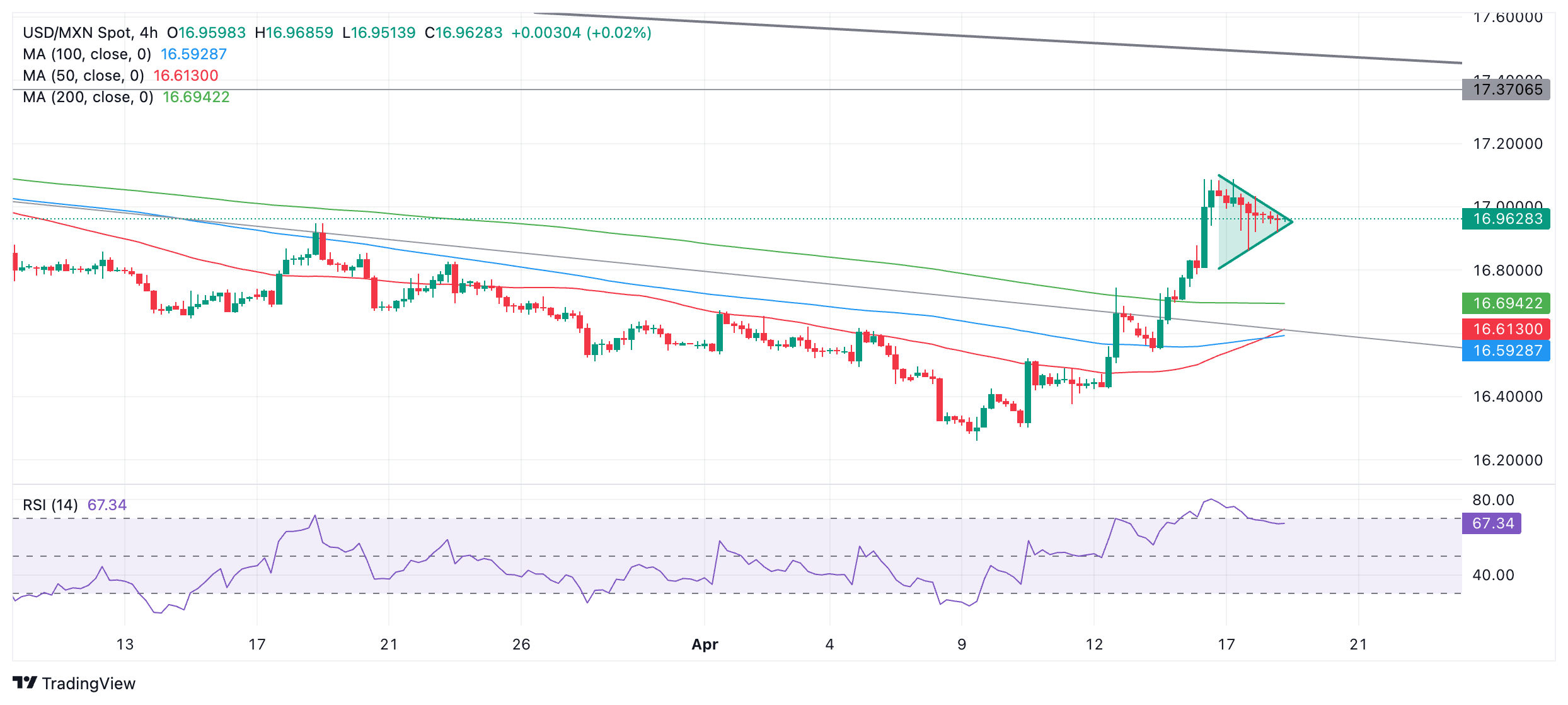Mexican Peso traces out a line after Banxico Heath’s comments
- The Mexican Peso consolidates after strengthening temporarily on Banxico Heath’s comments.
- USD/MXN forms a bullish Pennant price pattern on the 4-hour chart.
- The economic growth outlook for Mexico gets downgraded.
The Mexican Peso (MXN) traces a flat line on most charts on Thursday, as traders digest the previous day’s gains prompted by comments from Banxico Deputy Governor Jonathan Heath.
At its last meeting in March, Banxico decided to cut interest rates from 11.25% to 11.00%. However, Heath said that the bank would likely only make “fine adjustments” to interest rates going forward because stubbornly high inflation required them to remain elevated for some time yet.
It was necessary to ensure that “the restrictive monetary stance remains at these levels for as long as necessary until we see progress on inflation,” said Heath in an interview with Banorte’s Podcast on Wednesday.
Since the maintenance of higher interest rates is positive for a currency, because it attracts greater inflows of foreign capital, the Mexican Peso appreciated on the news.
Mexican Peso trending lower in April
The Mexican Peso has weakened overall in April despite Wednesday’s Heath-inspired recovery. This is mostly due to the Banxico cutting interest rates in March whilst the majority of major central banks continue to delay because of stubbornly high inflation.
The Peso may also have been hit by recent downgrades to growth forecasts for the Mexican economy from both the Banxico and the IMF.
“The forecast for Mexico is revised downward on account of weaker-than-expected outcomes for end-2023 and early 2024, with a contraction in manufacturing,” said the IMF in its latest World Economic Outlook report.
The fall off in economic growth is being put down to lower government spending in 2025, in order to bring down the country’s budget deficit.
However, it’s difficult to see how a programme of radical budget cuts would work politically.
Mexico will hold a presidential election on June 2, when it will also vote in the 628 deputies of the national assembly. It’s likely to be a two-horse race between the leading center-left candidates’ Claudia Scheinbaum and Xochitl Gálvez, according to Columbia Threadneedle Investments.
“We believe that regardless of who wins the election, Mexico is bound for a similar fate as other countries in the region, where governability has weakened and policy proposals have stagnated,” says Columbia Threadneedle on the outcome.
Given both candidates are of the left and likely to lead a weak government, expectations for budget tightening seem a little exaggerated, given the lack of maneuver foreseen to make unpopular decisions.
Technical Analysis: USD/MXN forms bullish Pennant
USD/MXN – the value of one US Dollar in Mexican Pesos – is consolidating in what could be a kind of bullish Pennant price pattern on the 4-hour chart.
The evolution of the Pennant suggests the likelihood of further upside if it breaks higher.
Given peaks and troughs are overall rising on the chart, the trend is likely bullish in the short-term, favoring long positions.
USD/MXN 4-hour Chart
The Relative Strength Index (RSI) has pulled back out of overbought into neutral territory, releasing the potential for more upside.
Support from the 50-day Simple Moving Average (SMA) at 16.82 is likely to put a line under further weakness.
A break above the peak of the Pennant at around 17.09 would indicate a continuation of the uptrend to the next target, possibly located at 17.17 where the 200-day SMA is situated, followed by resistance from a long-term trendline and resistance level at around 17.37.
Mexican Peso FAQs
The Mexican Peso (MXN) is the most traded currency among its Latin American peers. Its value is broadly determined by the performance of the Mexican economy, the country’s central bank’s policy, the amount of foreign investment in the country and even the levels of remittances sent by Mexicans who live abroad, particularly in the United States. Geopolitical trends can also move MXN: for example, the process of nearshoring – or the decision by some firms to relocate manufacturing capacity and supply chains closer to their home countries – is also seen as a catalyst for the Mexican currency as the country is considered a key manufacturing hub in the American continent. Another catalyst for MXN is Oil prices as Mexico is a key exporter of the commodity.
The main objective of Mexico’s central bank, also known as Banxico, is to maintain inflation at low and stable levels (at or close to its target of 3%, the midpoint in a tolerance band of between 2% and 4%). To this end, the bank sets an appropriate level of interest rates. When inflation is too high, Banxico will attempt to tame it by raising interest rates, making it more expensive for households and businesses to borrow money, thus cooling demand and the overall economy. Higher interest rates are generally positive for the Mexican Peso (MXN) as they lead to higher yields, making the country a more attractive place for investors. On the contrary, lower interest rates tend to weaken MXN.
Macroeconomic data releases are key to assess the state of the economy and can have an impact on the Mexican Peso (MXN) valuation. A strong Mexican economy, based on high economic growth, low unemployment and high confidence is good for MXN. Not only does it attract more foreign investment but it may encourage the Bank of Mexico (Banxico) to increase interest rates, particularly if this strength comes together with elevated inflation. However, if economic data is weak, MXN is likely to depreciate.
As an emerging-market currency, the Mexican Peso (MXN) tends to strive during risk-on periods, or when investors perceive that broader market risks are low and thus are eager to engage with investments that carry a higher risk. Conversely, MXN tends to weaken at times of market turbulence or economic uncertainty as investors tend to sell higher-risk assets and flee to the more-stable safe havens.


